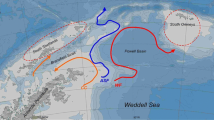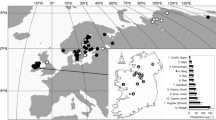Abstract
Many studies have examined latitudinal differences in reproduction of marine invertebrates, but few have measured variation at small to intermediate scales (kilometres to hundreds of kilometres), which may confound comparisons across broader geographic regions. Here, we examined variation in the reproductive biology of a little-studied species of burrowing ghost shrimp (Trypaea australiensis) at spatial scales ranging from km (between sites within estuaries) to 100s of km (among estuaries), over a 2-year period in south-eastern Australia. Sex ratios of populations were consistently biased towards females through time and space. Although reproduction started in summer months across all spatial scales, there was a pattern of earlier spawning from southern to northern estuaries. Integration of results from previous studies of T. australiensis supported a similar pattern of earlier breeding from high to low latitudes. Fecundity of shrimp increased linearly with female size, but the relationship varied inconsistently across the different spatial scales. Similarly, sizes at maturity varied from small to intermediate scales and observed patterns were not consistent with general predictions e.g. shrimp were smaller and ovigerous at smaller sizes at sites in the southern-most estuary, compared to estuaries further north. We found no differences in the sizes of embryos across the different spatial scales, but confirm that T. australiensis employs a strategy of high fecundity and small embryo size compared to other thalassinidean shrimp. Our results suggest that factors at smaller scales (e.g. food availability) may be important in affecting reproductive dynamics of T. australiensis, but further research is needed in testing hypotheses about patterns observed here. A lack of similar studies on other marine organisms remains an impediment to understanding life-history strategies and the sustainable management and conservation of populations.





Similar content being viewed by others
References
Aiken DE (1969) Ovarian maturation and egg laying in crayfish Orconectes; influence of temperature and photoperiod. Can J Zool 48:931–935. doi:https://doi.org/10.1139/z69-152
Aiken DE, Waddy SL (1989) Interaction of temperature and photoperiod in the regulation of spawning by American lobsters (Homarus americanus). Can J Fish Aquat Sci 46:145–148. doi:https://doi.org/10.1139/f89-019
Aiken DE, Waddy SL (1990) Winter temperature and spring photoperiod requirements for spawning in the American lobster, Homarus americanus, H. MILNE EDWARDS, 1837. J Shellfish Res 9:41–43
Anon (2008) Sunrise, sunset and twilight times. Geoscience Australia http://www.ga.gov.au/geodesy/astro/sunrise.jsp
Bay-Schmith E, Pearse JS (1987) Effect of fixed day lengths on the photoperiodic regulation of gametogenesis in the sea urchin Strongylocentrotus purpuratus. Invertebr Reprod Dev 11:287–294
Berkenbusch K, Rowden AA (2000) Latitudinal variation in the reproductive biology of the burrowing ghost shrimp Callianassa filholi (Decapoda: Thalassinidea). Mar Biol (Berl) 136:497–504. doi:https://doi.org/10.1007/s002270050709
Choy SC (1985) A rapid method for removing and counting eggs from fresh and preserved decapod crustaceans. Aquaculture 48:369–372. doi:https://doi.org/10.1016/0044-8486(85)90139-5
Clarke A (1987) Temperature, latitude and reproductive effort. Mar Ecol Prog Ser 55:111–119
Coleman N (1981) Notes on Callianassa (Crustacea: Thalassinidea) in Western Port, Victoria. Proc R Soc Vic 92:201–205
Defeo O, Cardoso RS (2002) Macroecology of population dynamics and life history traits of the mole crab Emerita brasiliensis in Atlantic sandy beaches of South America. Mar Ecol Prog Ser 239:169–179. doi:https://doi.org/10.3354/meps239169
Dugan JE, Hubbard DM, Wenner AM (1994) Geographic variation in life history of the sand crab, Emirita analoga (Stimpson) on the California coast. J Exp Mar Biol Ecol 181:255–278. doi:https://doi.org/10.1016/0022-0981(94)90132-5
Dumbauld BR, Armstrong DA, Feldman KL (1996) Life-history characteristics of two sympatric thalassinidean shrimps, Neotrypaea californiensis and Upogebia pugettensis, with implications for oyster culture. J Crustac Biol 16:689–708. doi:https://doi.org/10.2307/1549190
Dworschak PC (1988) The biology of Upogebia pusilla (PETAGNA) (Decapoda, Thalassinidea) III. Growth and production. PSZNI Mar Ecol 9:51–78. doi:https://doi.org/10.1111/j.1439-0485.1988.tb00198.x
Dworschak PC (2000) Global diversity in the Thalassinidea. J Crust Biol 20(Special Number 2):238–245
Felder DL (2001) Diversity and ecological significance of deep-burrowing macrocrustaceans in coastal tropical waters of the Americas (Decapoda: Thalassinidea). Interciencia 26:440–449
Felder DL, Lovett DL (1989) Relative growth and sexual maturation in the estuarine ghost shrimp Callianassa louisianensis, Schmitt 1935. J Crustac Biol 9:540–553. doi:https://doi.org/10.2307/1548586
Gaylord B, Gaines SD, Siegel DA, Carr MH (2005) Marine reserves exploit population structure and life history in potentially improving fisheries yields. Ecol Appl 15:2180–2191. doi:https://doi.org/10.1890/04-1810
Hailstone TS, Stephenson W (1961) The biology of Callianassa (Trypaea) australiensis Dana 1852 (Crustacea, Thalassinidea). Univ Queensl Pap Dep Zool 1:259–285
Hanekom N, Erasmus T (1989) Determinations of the reproductive output of populations of a thalassinid prawn Upogebia africana (Ortmann) in the Swartkops estuary. S Afr J Zool 24:244–250
Hastings MH (1981) The life cycle and productivity of an intertidal population of the amphipod Ampelisca brevicornis. Estuar Coast Shelf Sci 12:665–677. doi:https://doi.org/10.1016/S0302-3524(81)80064-3
Hilborn R, Walters R (1992) Quantitative fisheries stock assessment: choice, dynamics and uncertainty. Chapman and Hall, New York
Hill BJ (1977) The effect of heated effluent on egg production in the estuarine prawn Upogebia africana (Ortmann). J Exp Mar Biol Ecol 29:291–302. doi:https://doi.org/10.1016/0022-0981(77)90072-7
Imazu M, Asakura A (1994) Distribution, reproduction and shell utilization patterns in three species of intertidal hermit crabs on a rocky shore on the Pacific Coast of Japan. J Exp Mar Biol Ecol 184:41–65. doi:https://doi.org/10.1016/0022-0981(94)90165-1
Jones MB, Simons MJ (1983) Latitudinal variation in reproductive characteristics of a mud crab, Helice crassa (Grapsidae). Bull Mar Sci 33:656–670
Kenway MJ (1981) Biological studies of Callianassa australiensis (Dana). M.Sc. Thesis, Department of Zoology, James Cook University, Queensland, Australia
Kinne O (ed) (1970) Marine ecology, V. 1: environmental factors, part 1. A comprehensive, integrated treatise on life in oceans and coastal waters. Wiley, New York
Lardies MA, Castilla JC (2001) Latitudinal variation in the reproductive biology of the commensal crab Pinnaxodes chilensis (Decapoda: Pinnotheridae) along the Chilean coast. Mar Biol (Berl) 139:1125–1133. doi:https://doi.org/10.1007/s002270100661
Lester SE, Gaines SD, Kinlan BP (2007) Reproduction on the edge: large-scale patterns of individual performance in a marine invertebrate. Ecology 88:2229–2239. doi:https://doi.org/10.1890/06-1784.1
McPhee DP, Skilleter GA (2002a) Harvesting of intertidal animals for bait for use in a recreational fishing competition. Proc R Soc Queensl 110:93–101
McPhee DP, Skilleter GA (2002b) Aspects of the biology of the yabby Trypea australiensis (Dana) (Decapoda: Thalassinidea) and the potential of burrow counts as an indirect measure of population density. Hydrobiologia 485:133–141. doi:https://doi.org/10.1023/A:1021342306936
Nurse RP (1980) The reproduction, embryonic development and larval development of Callianassa australiensis (Dana), 1852. M.Sc. Thesis, University of Sydney
Oh CW, Hartnoll RG (2004) Reproductive biology of the common shrimp Crangon crangon (Decapoda: Crangonidae) in the central Irish Sea. Mar Biol (Berl) 144:303–316. doi:https://doi.org/10.1007/s00227-003-1205-6
Pezzuto PR (1998) Population dynamics of Sergio mirim (Rodrigues 1971) (Decapoda: Thalassinidea: Callianassidae) in Cassino Beach, southern Brazil. Mar Ecol (Berl) 19:89–109. doi:https://doi.org/10.1111/j.1439-0485.1998.tb00456.x
Phillips NE (2007) A spatial gradient in the potential reproductive output of the sea mussel Mytilus californianus. Mar Biol (Berl) 151:1543–1550. doi:https://doi.org/10.1007/s00227-006-0592-x
Poore GCB, Griffin DJG (1979) The Thalassinidea Crustacea Decapoda of Australia. Rec Aust Mus 32:217–321
Potter IC, Chrystal PJ, Loneragan NR (1983) The biology of the blue manna crab Portunus pelagicus in an Australian estuary. Mar Biol (Berl) 78:75–85. doi:https://doi.org/10.1007/BF00392974
Robertson AI (1977) Ecology of juvenile King George Whiting Sillaginodes punctatus (Cuvier & Valenciennes) (Pisces: Perciformes) in Western Port, Victoria. Aust J Mar Freshw Res 28:35–43. doi:https://doi.org/10.1071/MF9770035
Rotherham D, West RJ (2003) Comparison of methods for sampling populations of ghost shrimp, Trypaea australiensis (Decapoda: Thalassinidea: Callianassidae). Fish Res 60:585–591. doi:https://doi.org/10.1016/S0165-7836(02)00137-6
Rotherham D, West RJ (2007) Spatial and temporal patterns of abundance and recruitment of ghost shrimp (Trypaea australiensis) across hierarchical scales in south-eastern Australia. Mar Ecol Prog Ser 341:165–175. doi:https://doi.org/10.3354/meps341165
Rowden AA, Jones MB (1994) A contribution to the biology of the burrowing mud shrimp, Callianassa subterranea (Decapoda: Thalassinidea). J Mar Biol Assoc UK 74:623–635
Sachlikidis NG, Jones CM, Seymour JE (2005) Reproductive cues in Panulirus ornatus. NZ J Mar Freshw Res 39:305–310
Stearns SC (1976) Life history tactics: a review of ideas. Q Rev Biol 51:3–47. doi:https://doi.org/10.1086/409052
Tamaki A, Ingole B, Ikebe K, Muramatsu K, Taka M, Tanaka M (1997) Life history of the ghost shrimp, Callianassa japonica Ortmann (Decapoda: Thalassinidea), on an intertidal sandflat in western Kyushu, Japan. J Exp Mar Biol Ecol 210:223–250. doi:https://doi.org/10.1016/S0022-0981(96)02709-8
Thessalou-Legaki M, Kiortsis V (1997) Estimation of the reproductive output of the burrowing shrimp Callianassa tyrrhena: a comparison of three different biometrical approaches. Mar Biol (Berl) 127:435–442. doi:https://doi.org/10.1007/s002270050030
Tunberg B (1986) Studies on the population ecology of Upogebia deltaura (Crustacea: Thalassinidea). Estuar Coast Shelf Sci 22:753–766. doi:https://doi.org/10.1016/0272-7714(86)90097-1
Underwood AJ (1997) Experiments in ecology: their logical design and interpretation using analysis of variance. Cambridge University Press, Cambridge
Underwood AJ, Chapman MG, Connell SD (2000) Observations in ecology: you can’t make progress on processes without understanding the patterns. J Exp Mar Biol Ecol 250:97–115. doi:https://doi.org/10.1016/S0022-0981(00)00181-7
Wynberg RP, Branch GM (1991) An assessment of bait-collecting for Callianassa kraussi Stebbing in Langebaan Lagoon, Western Cape, and of associated avian predation. S Afr J Mar Sci 11:141–152
Acknowledgments
We are grateful to the various people that assisted with fieldwork on occasions. D.R held an Australian Postgraduate Award (APA) and received assistance from the School of Earth and Environmental Sciences at the University of Wollongong. This research complied with state and federal laws applying to New South Wales, Australia.
Author information
Authors and Affiliations
Corresponding author
Additional information
Communicated by P. Kraufvelin.
Rights and permissions
About this article
Cite this article
Rotherham, D., West, R.J. Patterns in reproductive dynamics of burrowing ghost shrimp Trypaea australiensis from small to intermediate scales. Mar Biol 156, 1277–1287 (2009). https://doi.org/10.1007/s00227-009-1169-2
Received:
Accepted:
Published:
Issue Date:
DOI: https://doi.org/10.1007/s00227-009-1169-2




